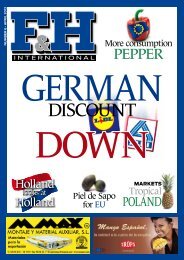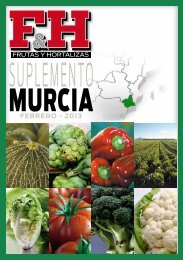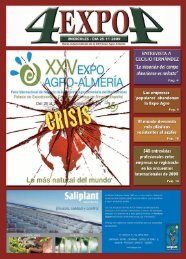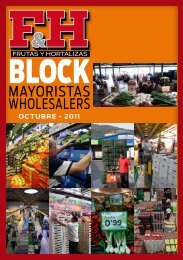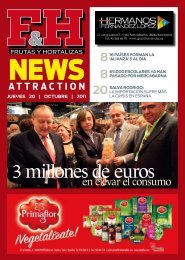Reporting On... - Revista F&H
Reporting On... - Revista F&H
Reporting On... - Revista F&H
You also want an ePaper? Increase the reach of your titles
YUMPU automatically turns print PDFs into web optimized ePapers that Google loves.
14<br />
The keys of the pear<br />
consumption in Spain<br />
THE PEAR CONSUMPTION IN SPAIN HAS<br />
DECREASED UNTIL 7.1 KILOGRAMS PER<br />
CAPITA, ALTHOUGH THE COMMERCIAL<br />
VOLUME INCREASED UNTIL 328,296<br />
TONS.<br />
By Daniel Lafuente<br />
Torregrosa<br />
revista@fyh.es<br />
The Spanish citizens consumed<br />
per capita in 2010<br />
an average of 7.1 kilograms<br />
of pears, which means a decrease<br />
of 300 grams and 400<br />
grams respecting to the years<br />
2009 and 2008. Of the total<br />
of this fruit consumed in<br />
Spain, 92.2 per cent is consumed<br />
at home, whereas the<br />
hotel industry and catering<br />
had a consumption of 2.2 per<br />
cent. <strong>On</strong> the other hand, 5.5<br />
per cent is the institutional<br />
consumption.<br />
Others<br />
1,0%<br />
Self-consumption<br />
4,0%<br />
Street markets<br />
5,0%<br />
Discounts<br />
6,0%<br />
Hypermarkets<br />
7,0%<br />
Local markets<br />
7,0%<br />
Travelling<br />
markets<br />
12,0%<br />
Traditional store<br />
30,0%<br />
F&H International 1 • November 2011 Markets<br />
By regions, the Castilla-León,<br />
Cataluña and Asturias are<br />
the Spanish zones of most<br />
consumption of pear, whereas,<br />
on the opposite Murcia,<br />
Canary Islands and Andalusia<br />
are the zones of less consumption<br />
of this fruit.<br />
Zones. The main pear consumptions<br />
are in the great<br />
metropolitan areas, followed<br />
so close by the rural zones,<br />
whereas the towns between<br />
2,000 and 10,000 inhabitants<br />
are the places of less<br />
consumption of pear. The<br />
families without children<br />
and singles are consume more<br />
quantity of this fruit and it<br />
Supermarket<br />
28,0%<br />
plAcEs of ThE<br />
purchAsE of pEArs<br />
In spAIn<br />
(In %). Souce: MARM.<br />
Prepared by F&H.<br />
decreases with the increase<br />
of the size of the family.<br />
Women who do not work,<br />
as well as the older than 65<br />
years are the people that include<br />
pear in their shopping<br />
basket, whereas the consumption<br />
is less among the<br />
younger than 35 years old.<br />
Supply. Like the rest of products<br />
of the fruit range, the traditional<br />
stores are the owners<br />
of the pear supply. The<br />
specialists and wholesalers<br />
manage this product because<br />
of this delicate product and<br />
makes easier a 30 per cent of<br />
the share of market among<br />
the traditional stores.<br />
And it is that one of the characteristics<br />
of the Spanish<br />
consumer is the acquisition<br />
of fruits in specialized stores,<br />
followed by the supermarkets<br />
with a share of 28 per<br />
cent thanks to their policy of<br />
promotions and price.<br />
EvoluTIon of ThE<br />
consuMpTIon of<br />
pEAr In spAIn<br />
(Kilos/per cápita)<br />
Source: MARM.<br />
6,96<br />
6,65<br />
The rest is divided and the<br />
traveling markets control<br />
12 per cent, followed by the<br />
hypermarkets and the street<br />
markets, both with seven per<br />
cent. The share of market of<br />
the discount stores is six per<br />
cent.<br />
Import. Spain is one of the<br />
great producers of this product,<br />
reason why the import<br />
is limited. Concretely, 17,260<br />
tons arrived into the Spanish<br />
borders for a business of 16.4<br />
million Euros in 2009.<br />
The pears coming from Belgium<br />
are becoming important,<br />
since the shipments sent<br />
by this country are an important<br />
part of the import of this<br />
fruit to Spain.<br />
Spain supplies its market<br />
with a production of more<br />
than 450,000 tons in the year<br />
2011 of which approximately<br />
125,000 tons are sent to the<br />
international market.<br />
7,48<br />
7,40<br />
7,16<br />
2006 2007 2008 2009 2010




